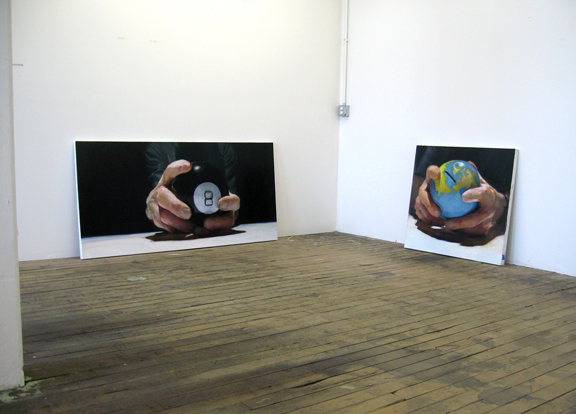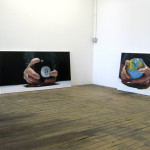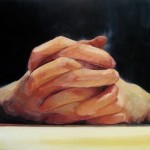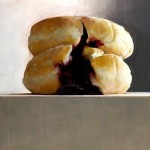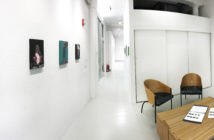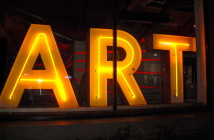Emily Eveleth is a New England based painter. She is represented by Howard Yezerski Gallery in Boston, and Danese in New York. She spoke with Julie Novakoff this past May.
Julie Novakoff: The lighting in your paintings could be described as luminecent - they appear as it they are coming out from the wall.
Emily Eveleth: In these images the directed lighting and the cropping of the figures both draw from film. I’ve always been interested in how that language has been used by painters. One of the things we didn't get a chance to talk about in our first conversation is the art historical precedent of cinematic aesthetics.
Later that evening I thought of images like Manet's Toreador and as I was leaving the MFA after our interview looked again atMemling's Christ from 1481. What I've always loved about the Memling is how the hands are painted so they look like they are resting on the frame - something that is coming into our actual space, the frame is in our world - as opposed to remaining in their illusionist space. It functions like an actor breaking the fourth wall. And in Manet's Toreador both the stark lighting is cinematic - though possibly more theatrical, now that I look at it - as is the cropping in the image, with the pink fabric being cut off on the left.
JN: Your use of lighting, saturation, and perspective has the ability to provoke an incredible curiosity about the unknown. This “unknown” is always connected to the object itself--for instance, in this series, the 8-ball. Can you tell us why/how these objects fascinate you?
EE: What I’m most interested in is working with point of view. The way point of view changes everything. With the works in this show, I wanted to create a feeling of time, to have the objects evoke a story line, a non- specific narrative, with a before, middle and after. In some of them I was looking to create a particular emotion, setting up the viewer to ask; what just happened?
The 8 ball, in particular, is a freighted object. It’s freighted with meanings that we bring to it. The 8-ball introduces many different possibilities about the "unknown", speculating on the future, on what's to come. A crystal ball also has that kind of openness, fraught with the apprehension, the anxiety, of what one might see in it. When the space in which these things and people are placed is familiar yet undefined, where the grounds can seem reminiscent of a stage, the image becomes free of associations of time and place.
JN: Is there anything in particular about Boston that feeds your work?
NN: There is a very collegial feel here, and a rich history and depth to the art scene. It’s great to be a part of it. I think, though, that many of the artists in Boston today don’t see it as a specific context for their work – things are too broad for that - and most likely, like me, they don’t define themselves by it. But to answer your question more directly, “what in particular about Boston feeds my work” are the things that are here; the Memling I mentioned, the Harry Callahan’s up now at the MFA, Degas’ portrait of Josephine Gaujelin at the Gardner, the Roni Horn show at the ICA. I’m still thinking about Cliff Ackley’s Rembrandt show at the MFA and the ICA’s Philip-Lorca diCorcia show. These are just the things that come first to mind.
JN: You have shown work at The Howard Yezerski Gallery in Boston and Danese Gallery in New York City for over a decade. Why did you choose to work with these particular galleries and in your opinion, how would you define their role?
NN: My first response is that it's a partnership. This is of course from an artist's point of view. And more than just partnership but ideally the gallery supports not just an artist's career, but also the growth of their work.
When I was first talking with Howard about joining the gallery there were three galleries I was considering at the time. What it came down to was: with whom did I want to work on a regular basis, talk to each week, and develop a partnership? What’s most important is to have someone who represents the work well and in both cities it’s great that I have that.
JN: Do you ever feel as if other series are overshadowed by the success of your doughnut series?
NN:: My two solo shows before this one were both of the doughnut series, so they’ve naturally been the most prominent recently. They were my focus in the studio for the four years I worked on the shows and then the most seen. The figurative series that came the year before though is still fresh in my mind – in fact I don’t have any of those paintings – no doubt I should have held on to one. Interestingly most of them went to collectors who also had doughnut paintings. Alternating between the two bodies of work, as I do, is a surprisingly natural shift. I think it’s because they relate to each other in some clear ways, like when there is contradiction between what is shown and how it’s portrayed or a play on what’s revealed and what’s concealed but also they relate in less obvious ways.
What I’m frequently after in both is generating a specific feeling, or an emotional state, say one of uncertainty, or of longing or of desire. The newest series is a little darker than the last, with more emphasis on feelings of uncertainty and longing, but there’s a strong connection and it’s wonderful when those correspondences between the two bodies of work jump out at you.
- Installation shot featuring 8-Ball and World Bank by Emily Eveleth.
- Emily Eveleth, Untitled, 2008, oil on board, 20 x 36″.
- Emily Eveleth, Unintended Consequences, 2008, oil on canvas, 68 x 60″.
Emily Eveleth
Howard Yezerski Gallery
All images are courtesy of the artist and Howard Yezerski Gallery.

